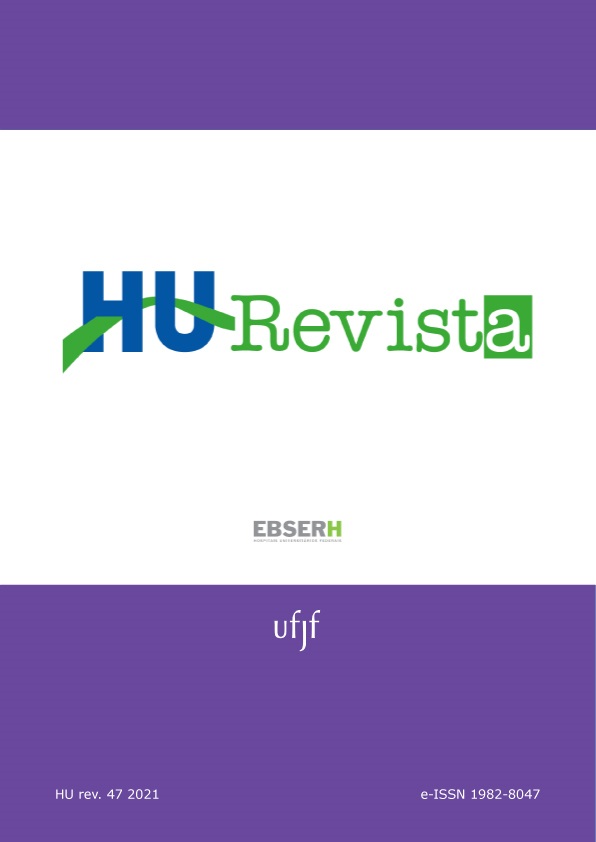Diagnosis of cardiac tamponade in neonatal cardiopulmonar arrest using point-of-care ultrasonography: case report
DOI:
https://doi.org/10.34019/1982-8047.2021.v47.34741Keywords:
Cardiac tamponade, Point-of-care Testing, Cardiopulmonary Heart ArrestAbstract
Introduction: Following the advances in medicine, ultrasound at the bedside (point-of-care ultrasound) has become a fundamental part of emergency medical assistance and emergency. The safety and ease of this exam make it a valuable tool to provide information in real time, helping to interpret signs and symptoms and, consequently, to make the diagnosis faster and more accurate. In the pediatric intensive care area, the point-of-care USG can be even more relevant, especially when it comes to the investigation of acute conditions, such as cases of neonatal cardiopulmonary arrest. Objective: To report a case of cardiorespiratory arrest due to cardiac tamponade in a pediatric patient and to highlight the importance of point-of-care ultrasonography in the diagnostic and therapeutic process of the case. Case Report: Premature newborn, female, born at 26 weeks and admitted to the Intensive Care Unit for support. The patient evolved with apnea and hemodynamic instability and subsequent cardiorespiratory arrest. In the diagnostic process, the main causes of cardiorespiratory arrest were investigated according to the American Heart Association's Pediatric Advanced Life Support protocol. After analyzing the symptoms and the patient's evolution, one of the main hypotheses suggested was cardiac tamponade, whose definitive diagnosis was made by means of point-of-care ultrasonography. Conclusion: Point-of-care ultrasonography has proved to be extremely important as it allows for a quick and accurate diagnosis, in addition to allowing adequate treatment and complete reversal of the patient's clinical condition. In addition, this test was able to show the probable cause of cardiac tamponade, revealing an intracardiac perforation possibly caused by the peripherally inserted central catheter used in the patient.
Downloads
References
Bertuzzi BD, Pedrollo DF, Rodrigues MS, Oliveira ACT, Liberato G. Ultrassom à beira do leito na prática pediátrica. In: Piva JP, Carvalho WB. PROTIPED: programa de atualização em terapia intensiva pediátrica: ciclo 8. Artmed Panamericana. 2017; 4(1):91-132.
McLario DJ, Sivitz AB. Point-of-care ultrasound in pediatric critical care. Jama Pediatr. 2015; 169(6):594-600.
Srinivasan S, Cornel TT. Bedside ultrasound in pediatric critical care: a review. Pediatrics Critical Care Medicine. 2011; 12(6):667-74.
Gaspar HÁ, Morhy SS. The role of focused echocardiography in pediatric intensive care: a critical appraisal. BioMed research international. 2015; 1(1):1-7. https://doi.org/10.1155/2015/596451
Doniger SJ. Bedside emergency cardiac ultrasound in children. Journal of Emergencies, Trauma and Shock. 2010; 3(3):282. https://doi.org/10.4103/0974-2700.66535
Hopkins A, Doniger SJ. Point-of-care ultrasound for the pediatric hospitalist’s practice. Hospital Pediatrics. 2019; 9(9):707-18.
EL-Khuffash A. Neonatal echocardiography teaching manual [Internet]. 2014. [citado em 2019 jan. 25]. Disponível em: https://www.researchgate.net/publication/306030785_Neonatal_Echocardiography_Teaching_Manual
Corredera A, Rodriguez MJ, Arévalo P, Llorente B, Moro M, Arruza L. Functional echocardiography in neonatal intensive care: 1-year experience in a unit in Spain. Analesdepediatria. 2014; 81(3):167-73.
Leal GN, Lianza AC. Ecocardiograma para o intensivista pediátrico e neonatal. In: Piva JP, Carvalho WB. PROTIPED: programa de atualização em terapia intensiva pediátrica: ciclo 8. Artmed Panamericana. 2016; 2(1):59-106.
Cotogni P, Pittiruti M. Focus on peripherally inserted central catheters in critically ill patients. World Journal of Critical Care Medicine. 2014; 3(4):80.
Shaw JC. Parenteral nutrition in the management of sick low birth weight infants. Pediatr Clin North Am. 1973; 20(2):333-58.
Ohki Y et al. Complications of peripherally inserted central venous catheter in Japanese neonatal intensive care units. Pediatrics International. 2013; 55(2):185-9.
American Heart Association. Destaques das diretrizes da american heart association para RCP e ACE [Internet]. [citado 2016 ago. 25]. Disponível em: https://eccguidelines.heart.org/wpcontent/uploads/2015/10/2015-AHA-Guidelines-HighlightsPortuguese.pdf
Domingues VS. Tamponamento cardíaco da etiologia ao tratamento. Cuidados Intermédios em Perspectiva. 2012; 1(1):29-35.
Raval NC, Gonzalez E, Bhat AM, Pearlman SA, Stefano JL. Umbilical venous catheters: evaluation of radiographs to determine position and associated complications of malpositioned umbilical venous catheters. Am J Perinatol. 1995; 12(3):201-4.
Downloads
Published
How to Cite
Issue
Section
License
Copyright (c) 2021 Matheus Novelli, Alana Balbueno, Eduarda Demoner Paseto, Igor Marinho Pereira, Ronaldo Afonso Torres

This work is licensed under a Creative Commons Attribution 4.0 International License.
Cessão de Primeira Publicação à HU Revista
Os autores mantém todos os direitos autorais sobre a publicação, sem restrições, e concedem à HU Revista o direito de primeira publicação, com o trabalho licenciado sob a Licença Creative Commons Attribution que permite o compartilhamento irrestrito do trabalho, com reconhecimento da autoria e crédito pela citação de publicação inicial nesta revista, referenciando inclusive seu DOI.









